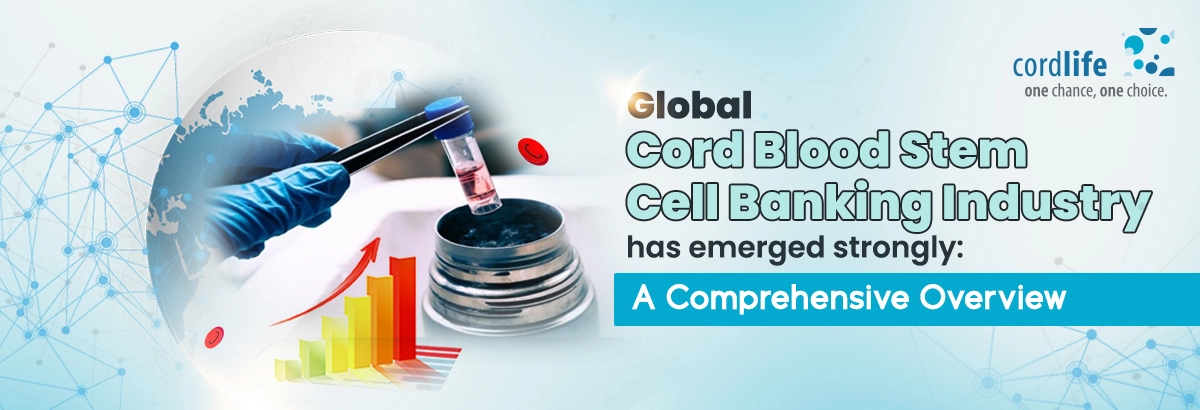Table of Contents
Stem cells form the basis of the body. For instance, if you have an injury, or there is a bruise or cut in your body, or maybe you’re ageing, and some of your body’s functions may be a little impaired, these stem cells in your body have the natural ability and potential to form specialised cells that help in replacing and restoring the damaged or impaired part of the body’s functions.
Stem cell-based therapy has the potential to revolutionize the field of regenerative medicine and significantly improve the body’s ability to repair and regenerate damaged tissues. By stimulating and regulating the natural stem cell population, as well as replenishing the cell pool, stem cell therapy has the potential to enhance tissue homeostasis and promote overall healing and regeneration.
Stem cell preservation is the first and primary step towards stem cell therapy.
Check Out the Market Dynamics of Stem Cells and Stem Cell Banking
Stem cell banking has grown in popularity, over the last few decades. This offers the opportunity to cryogenically store stem cells at the most potent state. The demographic transition of stem cells and the stem cell banking industry has a significant impact on healthcare dynamics globally. Cardiovascular diseases, osteoarthritis, cancer as well as neurological problems are some of the examples. The ageing population, however, may suffer from Alzheimer’s and Parkinson’s disease. The demand for stem cell therapy and stem cell banking services is rising due to the growing awareness of the regenerative potential of stem cells among the ageing population. The older people are seeking better healthcare options, positioning the market for long-term growth. The stem cells hold enormous promise of rebuilding the damaged tissues, thus opening doors to novel treatment methods, and improving the quality of life.
Stem Cell Segmentation Market Analysis
The stem cells are segmented into embryonic stem cells, adult stem cells, and induced pluripotent stem cells. (According to research, from 2018 to 2023, global stem cell banking is expected to reach USD 9.30 to 9.42 billion, at a CAGR of 8.2% to 8.4%.) Maybe the use and research of embryonic stem cells have been a source of ethical discussion, but adult stem cells and cord blood stem cells encourage potential stem cell therapies without any kind of ethical or legal ambiguity.
Cord Blood Banking and Its Services
Cord blood stem cells among other stem cells have gained a lot of popularity in the last few decades as it is a rich pool of haematopoeitic stem cells. As per the records, cord blood banking emerged as a commercial service as early as the 1990s.
By the Early 1990s
The first-ever cord blood-derived haematopoietic stem cells were performed in 1988 for Fanconi Anaemia. Till now, the treatment of Fanconi Anaemia has been considered the most essential achievement across the umbilical cord blood and progenitor stem cells.
By the Middle of the 2000s
By the middle of the 2000s, the growing number of cord blood banking companies, started investigating cord blood for the pilot as well as clinical trials for disorders like autism, cerebral palsy, and hearing loss.
By 2023
By April 2023, the U.S. FDA affirmed the world’s first-ever allogeneic cord blood stem cell therapy to further encourage the recovery of white blood cells in cancer patients. Research has further shown that the umbilical cord blood stem cells are employed in treating over 80 life-threatening diseases – for instance – blood cancer (lymphomas and leukaemia), and metabolic, immunological, and genetic disorders.
Since the early 1990s saw some major developments in cord blood stem cell therapy, during that time, a Taiwanese cord blood banking company was the very first to offer the cord blood banking service. Since the early 2000s, the cord blood banking industry has developed exponentially, as requires safe cord blood storage options among parents-to-be in Europe, the U.S., Asia, and the Indian subcontinent. With the constant rise in per capita income and public awareness, cord blood banking services are only expected to rise.
Families nowadays understand the essence of preserving cord blood stem cells, thus morally contributing to the industry’s growth.
Global Cord Blood Corporation (GCBC), Cord Blood Registry (owned by CooperSurgical), and ViaCord are some of the well-known names among private cord blood banking companies.
One of the leading names in private cord blood banks in Asia is Cordlife India, offering total stem cell banking solutions to new parents – from cord blood collection to cryopreservation. In this stage, all that the parents need to do is pay a nominal price, as Cordlife India gives value and benefits they get paid for.
